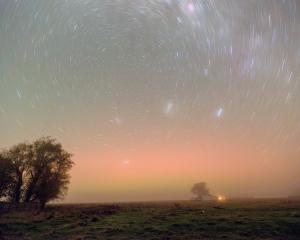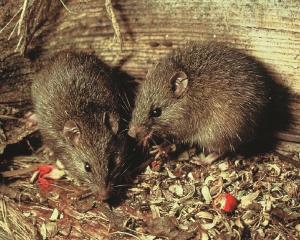Te Kaha, a 118m-long frigate, the pride of the New Zealand Navy, and her crew of 179, was being given a little taste of one the Southern Ocean's moods.
When she left Bluff on Operation Endurance, with a complement of Department of Conservation staff last Sunday, the sea was like a mirror.
As her turbine engines cranked up she ripped south past Stewart Island at 27 knots.
The joint mission was to deliver a large quantity of boardwalk, about 30 tonnes (to be used to extend 2.5km of boardwalk by 750m), to the subantarctic islands of Campbell and Enderby, restock fuel dumps for search and rescue missions, and look for any spread of the invasive seaweed undaria (recently discovered at the nearby Snares), among other things.
But with no landmass to impede their charge, storms rip across the Southern Ocean's latitudes, making sea travel unpredictable, at best.
The prevailing westerly wind can rapidly whip a tranquil sea into a frenzied and unforgiving cauldron.
The following night, Te Kaha was well battened down as she reduced her speed by half to punch into the 50-knot winds, 6m swells, and shudder through regular 10m peaks.
Geographically isolated, 200km to 700km south of Bluff, and away from popular shipping routes, the five subantarctic island groups, comprising the Snares, Auckland, Bounty, Antipodes and Campbells are relatively unspoiled havens for their indigenous inhabitants and contain some of the least-modified landforms in the world.
Following a nomination researched and compiled by Dunedin conservationist and author Neville Peat, the islands were designated a World Heritage Area in 1998, winning the same status as the Great Barrier Reef and the Grand Canyon.
The Department of Conservation, which is charged with managing and protecting the islands, enforces strict quarantine procedures for anyone landing on the islands.
This is to ensure there are no accidental introductions of pests, plants or pathogens.
Before embarking on Te Kaha, all passengers were subjected to a rigorous inspection of clothing and equipment, particular attention being paid to the inside of pockets and Velcro where small seeds could go unnoticed.
Boots are also dipped in Vircon, an antibacterial solution, as a guard against pathogens, before leaving the ship.
Campbell Island
Campbell Island, the most southerly of the subantarctic crop at 700km south of Bluff was covered by ominous black clouds as we steamed between the cliffs guarding the entrance to Perseverance Harbour.
The harbour is named after a sealing vessel that both discovered the island in 1810 and was wrecked there in 1829.
The landing has a small concrete jetty, making Campbell the only island which offers the luxury of dry feet. All of the others require wading from an inflatable to shore.
The jetty is also a favourite resting place for boisterous sea lions, giving new visitors, in particular it seems, an unnerving welcome involving a gruff-voiced charge, with mouth wide open and yellowed teeth exposed, to within a metre or less.
Most noticeable on Campbell Island is the lack of trees. A band of very dense scrub covering the lower slopes changes to antarctic snow tussock above.
The single introduced spruce tree on the island is listed in the Guinness Book of Records as the loneliest tree in the world.
Attempts at farming started on the 12km by 12km island in 1895 with the release of 300 to 400 sheep and continued until 1931. Since the last of the sheep were shot by Doc in the early '90s large areas of colourful, vibrant megaherbs have re-established.
In July 2001, in the largest such operation ever staged, four helicopters spread 120 tonnes of cereal bait over the island, successfully eradicating its rats.
More than 30 species are now benefiting from the work, including the endangered teal and snipe.
The endangered Campbell Island pipit, a ground dweller, was wiped out on the main island by rats, but has repopulated from the outer islands. It is now a common sight and seemingly unafraid of visitors, accompanying them all over the island.
From the landing, past the amorous sea-lions, through the tight scrub, you take a boardwalk in the shadow of Beeman Hill to the snow tussock where, scattered like confetti, southern royal albatross nest.
Campbell Island is the stronghold of the species with about 14,000 breeding pairs. They vary only slightly in genetics from the northern royal albatross.
This week, with no chicks yet hatched, some birds sit on nests among the megaherbs, juveniles are gamming (a courtship display for next year's mating), while the sky is alive with gracefully soaring birds whose whoosh can be heard as they swoop close by.
Even when sticking to the boardwalk, put in place to minimise impacts on the fragile peat soil, it is often hard to obey the Doc instruction to stay 5m away from the wildlife.
Not only do the birds move freely around and cross the boardwalk, but some have even built their nests right beside it.
Peter Moore, from the Department of Conservation's research and development division, is into his fifth year leading a team studying the productivity and survival of the albatross.
He has no problem with limited numbers of tourists visiting the island as long as disturbance is kept to a minimum and they obey the 5m rule. Following the end of farming, numbers of the birds steadily built up but the population growth has levelled off in the past 10 years.
Moore says long-term changes in the environment are the albatross' biggest concern, brought on by the impact of humans on the global environment far away from the island.
Auckland Islands
Entering Carnley Harbour of the Auckland Islands, some 460km south of Bluff, the most obvious feature is a cruise ship.
Several inflatable boats zip around as tourists enjoy a subantarctic experience. The MV Orion is one of five cruise ships visiting the islands this year.
Only 600 visitor permits are issued a year, though cruise ship operators are lobbying to have the number increased.
Strict quarantine is observed for both the passengers and the ship, it must have its hull inspected by a diver before entering these waters and a Doc representative is present on every trip.
This was the Orion's second visit to the sub-Antarctic islands on this cruise. Gathering pack-ice meant they could not enter the Ross Sea so they called in on the way back to port.
The Auckland Islands have a colourful history of shipwrecks, with at least eight recorded between 1864 and 1907, involving the loss of 121 lives. The most famous wreck was that of the General Grant, crushed against the towering Western Cliffs in 1866.
After being marooned for 18 months the 10 surviving passengers, from a complement of 83, were rescued by a sealing vessel.
Another compelling story is that of the Grafton, driven aground in Carnley Harbour during a violent storm in 1864. The five-strong crew showed remarkable adaptability, crushing and firing shell to make cement for a dwelling, tanning seal hide for clothing and building a forge from material salvaged from the wreck.
They extended the ship's dinghy, fitted a mast and sails and, after 19 months, three of the castaways sailed to Stewart Island.
As was the fashion of the time, pigs, goats and rabbits were released on these islands to provide food for castaways.
While the best thing for the islands would be the complete removal of all of these introduced species, in some cases the size and the isolation of the islands means that this has to be balanced against other priorities.
In an interesting twist, the prolonged isolation of Auckland Island's pigs from other pigs means they are now considered the most disease-free pigs in the world and could play an important role in the search for a cure for type 1 diabetes.
Enderby Island
At the northern end of the Auckland Island group is Enderby Island, a sea lion capital which has seen much human activity over the years.
It was once a sealing base, was used by European and Maori farmers and also as a haven for shipwrecked castaways.
A waist-deep plunge into the 9degC ocean is soon forgotten as Sandy Bay, littered with sea lion bulls, females and pups, leads up to a low-growing rata forest and out on to hummocky moors where albatross nest and megaherbs flourish.
While two species of penguin breed on the Auckland Islands, the most conspicuous are the yellow-eyed penguins on Enderby, with 250-300 breeding pairs.
Once the boardwalk and fuel were unloaded, and the helicopter and inflatable boats were stowed it was time to leave the subantarctic island group and its unique flora and fauna.
We, richer with our photographs and experiences, and the islands, no poorer for our passing.













